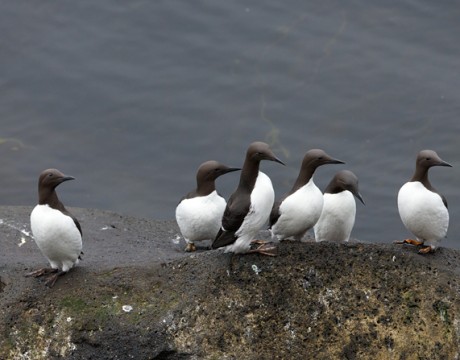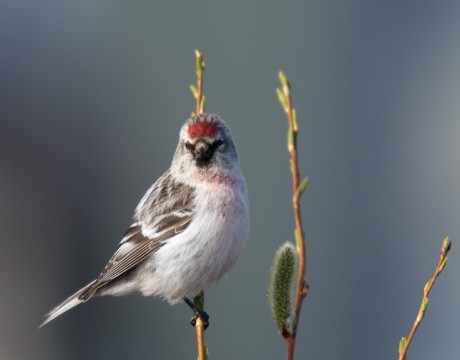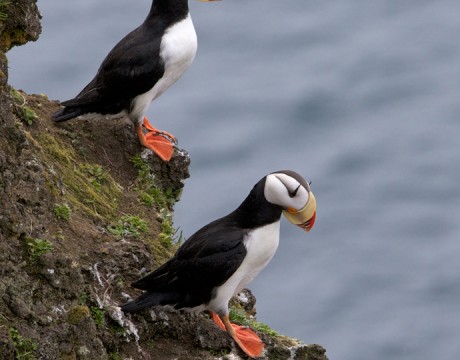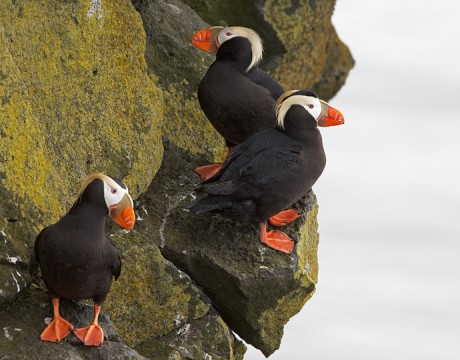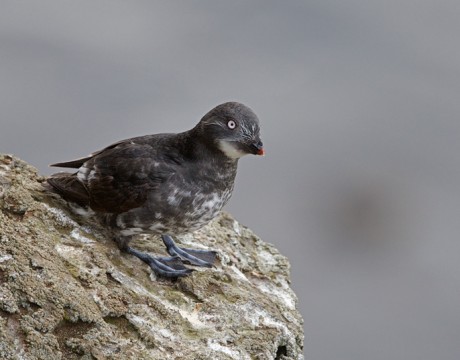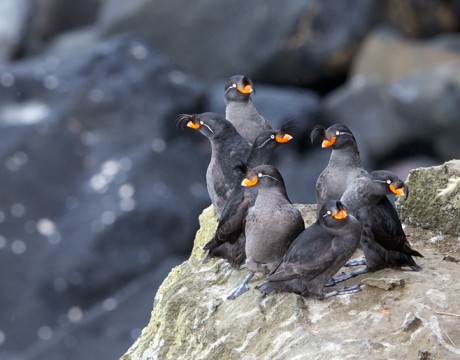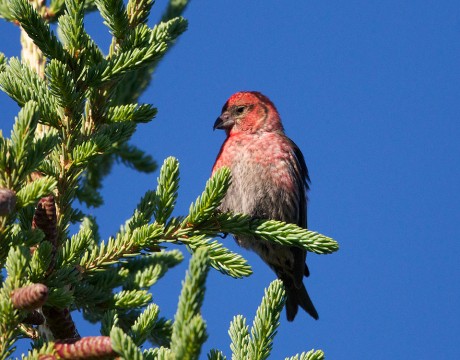Bird of the Week – Thick-billed Murre
The close cousin of last week’s Common Murre, the Thick-billed Murre is slightly larger, slightly darker and has the distinctive whitish “gape” at the back of the bill. The Thick-billed Murre is believed to spend most of the year further offshore, in deeper water, than the Common Murre. It’s a challenge to tell the two species apart in the field. Here’s a comparatively rare shot of the two species, side-by-side. All of this is probably more about Alcids than most Mudpuppies ever wanted to know. It’s a peril of hanging around birders. But we’ll set Alcidae aside for a while…
Bird of the Week – Common Murre
But wait, there are more Alcids! Certainly including the very Common Murre. WC has received criticism that he only posts photos of single birds. Well, duh! But for variety, at least, here a group shot of half a dozen of Alaska’s most common Alcid, the Common Murre. A Common Murre colony is a very noisy, crowded place, with many of their long, moaning “Ooooaaarrr” calls. When alarmed by a predator, or an encroaching, careless birder, they stream off their cliff colony is a silent waterfall of black and white birds, calling only as they level out of the ocean waves….
Bird of the Week – Hoary Redpoll
Around the holidays, WC likes to post a bird that is at least kind of Christmasy. The challenge is that Alaska just doesn’t have that many Christmasy birds, and WC is starting to have to reach a bit. Here’s a Hoary Redpoll. A paler version of its more ubiquitous Common Redpoll cousin, the Hoary seems to prefer more northerly habitat. On a day when WC might have 100 Common Redpolls at this feeders, there might be just one or two Hoarys. There’s some excitement about Hoary Redpolls in ornithological circles; bird researchers haven’t figured out their taxonomy. For WC, it’s…
Bird of the Week – Parakeet Auklet
Yes, there are a lot of Alcids. Here’s another one, the Parakeet Auklet. The white line behind the eye is a plume, a very long, narrow white feather, that appears in breeding season. Like most birds, the shape of the bill tells you a lot about the species’ preferred food. The Parakeet’s bill is adapted to gelatinous prey like small jelly fish. Mated pairs have a charming, bill-tapping routine when they greet each other. Camera geek stuff: f16, 1/250 ISO1000 For more bird photos, please visit Frozen Feather Images.
Bird of the Week – Horned Puffin
Last week’s bird, the Tufted Puffin, has a close cousin that’s almost as colorful, Alaska’s other puffin, the Horned Puffin. The “horns” aren’t really horns; they are fleshy knobs that appear in breeding season. For a bird that is relatively common, they are poorly studied. but are believed to be the most pelagic of Alcids, spending most of their lives far out in the ocean, coming ashore only to breed, and then only after several years. Camera geek stuff: f18, 1/500 ISO1000 For more bird photos, please visit Frozen Feather Images.
Bird of the Week – Tufted Puffin
From the smallest Alcid to the largest Alcid, the Tufted Puffin. WC has received complaints that Alcids aren’t very colorful. We’ll address that, too. At just under 16 inches long, the Tufted Puffin is more than three times bigger than its diminutive cousin, the Least Auklet. The flashy plumes are a breeding season characteristic, as are the electric-orange legs and feet. (Technically, this is the second time Tufted Puffin has been the Bird of the Week. But the earlier post was a captive bird, at the Alaska Sealife Center. These are wild birds, on St. Paul Island, in the Priiblofs.)…
Bird of the Week – Least Auklet
The smallest Alcid – the smallest seabird in North America – is the tiny Least Auklet Just a bit over six inches long, it makes up in abundance what it lacks in size. There are an estimated 20 million Least Auklets in Alaska waters. The oversized feet help it dive and swim under water for zooplankton. Despite its tiny size, it is recorded as diving to 75 meters or more. A Least Auklet eats about 90% of its body mass in food each day. When you consider the population, the sheer fertility of the Bering Sea and Gulf of Alaska is…
Bird of the Week – Crested Auklet
WC has neglected the Alaska alcids, the “flying footballs” of Alaska waters. Alaska doesn’t have penguins – whatever they may think in the Lower 48 – but we come close with these diving seabirds. We’ll start with a species that always makes WC smile, Crested Auklets. The crest is a sexual characteristic in both genders; both males and females prefer a mate with a big crest. Let the innuendo begin. Camera geek stuff: f14, 1/60 ISO1000 For more bird photos, please visit Frozen Feather Images.
Bird of the Week – Red-faced Cormorant
Alaska is the only place in North America where you can find the Red-faced Cormorant. Cormorants dive for fish, and nest on cliffs and ledges like the bluffs of St. Paul Island. The body appears black, but actually has a greenish-purplish cast, best seen on cloudy days. Camera geek stuff: f4, 1/8000 ISO100 For more bird photos, please visit Frozen Feather Images.
Bird of the Week – White-winged Crossbill
White-winged Crossbills are evergreen cone specialists. You can see that the bill does indeed cross at the tips, allowing the bird to lever open spruce and tamarack cone bracts to get to the seeds. The male is a lot flashier. White-winged Crossbills aren’t always easy to find. They follow the cone crop. When spruce and tamarack cone production is low, the birds will move elsewhere. This is a boreal species; further south, even in Southeast Alaska, the Red Crossbill is more common. Camera geek stuff: f5.6, 1/8000, ISO2500 For more bird photos, please visit Frozen Feather Images.






